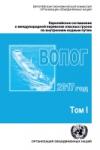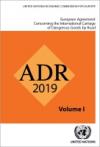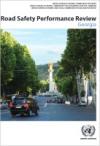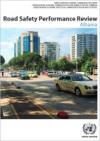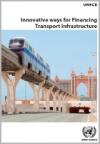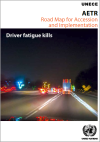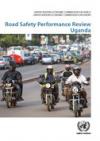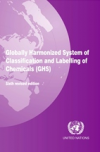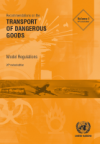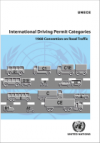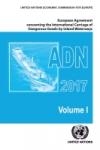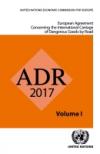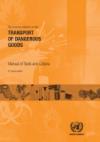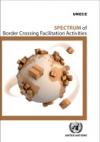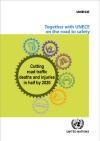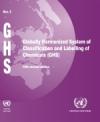Publications
Displaying Results 41 - 60 of 200
- English
In 2010, the United Nations General Assembly (resolution 64/255) proclaimed a Decade of Action for Road Safety ("Decade"). As part of the Sustainable Development Goals (SDGs), the goal of the Decade (2011-2020) is to stabilize and then reduce the forecast level of road traffic deaths around the world. SDG 3.6 By 2020 halve the number of global deaths and injuries from road
- English
The European Agreement concerning the International Carriage of Dangerous Goods by Inland Waterways (ADN) done at Geneva on 26 May 2000 under the auspices of the United Nations Economic Commission for Europe (UNECE) and the Central Commission for Navigation on the Rhine (CCNR) has been in force since February 2008. The Agreement currently has eighteen Contracting Parties. The Regulations
- English
Adopted on 30 September 1957 in Geneva under the auspices of the United Nations Economic Commission for Europe (UNECE), the ADR entered into force on 29 January 1968. This authoritative Agreement is intended to increase the safety of international transport of dangerous goods by road. Its Annexes A and B contain the technical requirements for road transport, i.e. the conditions under
- English
Road safety is an important sustainable development goal, yet relatively underappreciated and greatly underfunded. Every year, more than 1.2 million people die and another 50 million are injured in road traffic accidents around the world. Approximately 90% of all road accidents occur in low- and middle-income countries.Recognizing the need to support member States in urgently and effectively
- English
Road safety is an important sustainable development goal, yet relatively underappreciated and greatly underfunded. Every year, more than 1.2 million people die and another 50 million are injured in road traffic accidents around the world. Approximately 90% of all road accidents occur in low- and middle-income countries.Recognizing the need to support member States in urgently and effectively
- English
During recent decades governments all around the world were faced with a complicated set of options for investing in transport, including transport infrastructure. This publication examines main principles for determining the most appropriate models for financing transport infrastructure expenditures but also illustrates and analyses many innovative ways to finance transport infrastructure.
- English
- English
This report presents the results of the project Safe Future Inland Transport Systems (SafeFITS), which aims to develop a robust road safety decision-making tool to support the most appropriate road safety policies and measures to achieve tangible results.
The SafeFITS tool is composed of three complementary modules:
Intervention analysis: allows the user to examine the effects of single
- English
Every year, as a consequence of road traffic crashes, more than 1.2 million people are killed globally, while another 50 million are injured. Approximately 90% of all road crashes occur in low- and middle-income countries.Even though road safety is an important sustainable development issue, it is yet relatively underappreciated and greatly underfunded. Recognizing the need to support Member
- English
The GHS addresses classification of chemicals by types of hazard and proposes harmonized hazard communication elements, including labels and safety data sheets. It aims at ensuring that information on physical hazards and toxicity from chemicals be available in order to enhance the protection of human health and the environment during the handling, transport and use of these chemicals.The GHS
- English
These recommendations have been developed in the light of technical progress, the advent of new substances and materials, the exigencies of modern transport systems and, above all, the requirement to ensure the safety of people, property and the environment. They are addressed to governments and international organisations concerned with the regulation of the transport of dangerous goods. The
- English
The brochure on International Driving Permit Categories recommends reconciliations of the differences between the International Driving Permit categories in the 1968 Convention on Road Traffic and the corresponding definition for the same symbol in the EU Driving Licence Directive (2006/126/EC of 20
- English
The European Agreement concerning the International Carriage of Dangerous Goods by Inland Waterways (ADN) done at Geneva on 26 May 2000 under the auspices of the United Nations Economic Commission for Europe (UNECE) and the Central Commission for Navigation on the Rhine (CCNR) has been in force since February 2008. The Agreement currently has eighteen Contracting Parties.The Regulations
- English
Adopted on 30 September 1957 in Geneva under the auspices of the United Nations Economic Commission for Europe (UNECE), the ADR entered into force on 29 January 1968.This authoritative Agreement is intended to increase the safety of international transport of dangerous goods by road. Its Annexes A and B contain the technical requirements for road transport, i.e. the conditions under which
The United Nations Transport Conventions on border crossing facilitations – Benefits for governments
- English
This leaflet, prepared by the Sustainable Transport Division of the UNECE in cooperation with the International Road Transport Union (IRU), highlights the importance and potential benefits to Contracting Parties of the Customs Convention on the International Transport of Goods under Cover of TIR Carnets and the International Convention on the Harmonization of Frontier Controls of Goods.It
- English
ST/SG/AC.10/11/Rev.6Sales No. E.15.VIII.3ISBN 978-92-1-139155-8Price: US$ 125Languages: E, F, S (A, C, R forthcoming)How to order this publication?This publication is also available online for free (download).The Manual of Tests and Criteria contains criteria, test methods and procedures to be used for classification of
- English
The inclusion of urban transport in the SDG 11 is further confirmation that transport is an essential component of the overall sustainable development. It is crucial to eradicating poverty and economic growth (access to markets and jobs), improving education (access to schools), protecting child and maternal health (access to medical services), and enhancing
- English
- English
Cutting road traffic deaths and injuries in half by 2020Download the publication hereThe world has been paying serious attention to road safety since 2003, following a United Nations General Assembly Resolution on the rapid global increase in road traffic deaths, injuries and disabilities. With roughly 1
- English
The GHS addresses classification of chemicals by types of hazard and proposes harmonized hazard communication elements, including labels and safety data sheets. It aims at ensuring that information on physical hazards and toxicity from chemicals be available in order to enhance the protection of human health and the environment during the handling, transport and use of these chemicals.The GHS



